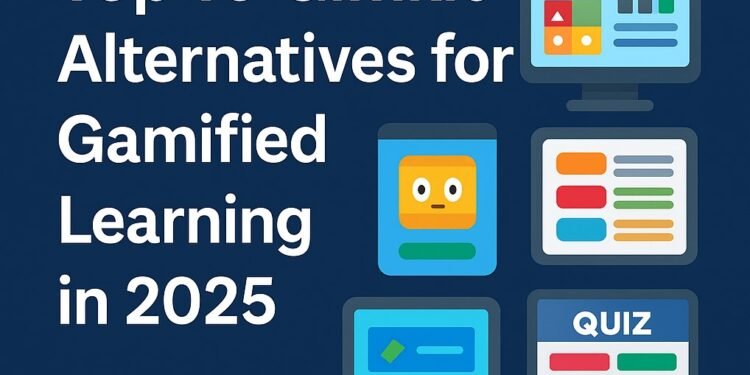Introduction: Beyond Gimkit—The Rise of Gamified Classrooms
In 2017, Gimkit burst onto the scene as a student-built platform that turned quizzes into competitive, game-like sessions. Teachers loved it, students loved it even more, and suddenly classrooms started sounding more like game shows than lecture halls.
But here’s the truth: Gimkit isn’t the only game in town. In fact, the global game-based learning market is projected to reach $67.5 billion by 2030 (Fortune Business Insights, 2024). With that kind of growth, dozens of platforms are innovating new ways to engage learners.
So, if you’ve used Gimkit and are curious about other tools—or if you’re just starting your gamification journey—this guide covers the top 10 Gimkit alternatives for 2025, complete with pros, cons, and real-world applications.
1. Kahoot!
Perhaps the most well-known alternative, Kahoot! is synonymous with classroom gamification.
📊 Case Example: A 2023 study by Edutopia showed student participation increased 42% when using Kahoot instead of worksheets.
2. Quizizz
Quizizz blends gamification with homework-style assignments.
🎯 Best For: Teachers balancing in-class and after-class assessments.
3. Blooket
If Gimkit feels like Monopoly, Blooket feels like Mario Kart.
4. Nearpod
While not purely a quiz platform, Nearpod offers interactive lessons with gamification elements.
🎓 According to a Stanford University report on interactive learning, tools like Nearpod improve comprehension for digital-native learners.
5. Quizlet Live
A spin-off from Quizlet’s flashcard system, Quizlet Live makes group learning competitive.
6. Classcraft
Classcraft takes gamification to the next level—turning the entire classroom into a role-playing game.
7. Factile
A Jeopardy-style quiz platform, Factile is perfect for review sessions.
8. Socrative
Focused more on assessment, Socrative brings gamified quizzes into teacher-driven lessons.
📊 A U.S. Department of Education report notes that formative assessments like those enabled by Socrative help boost achievement by providing real-time feedback.
9. Pear Deck
Like Nearpod, Pear Deck integrates gamified questions into presentations.
10. Brainscape
For teachers who want data-driven flashcard learning, Brainscape is a top contender.
📖 Research shows spaced repetition improves retention rates significantly (NCBI).
How to Choose the Right Gimkit Alternative
When selecting a tool, consider:
-
Your Teaching Goals – Do you want review games, long-term gamification, or formative assessment?
-
Age Group – Younger students may prefer flashy tools (Kahoot, Blooket), while older ones benefit from structured options (Socrative, Brainscape).
-
Budget – Many platforms limit features in free versions.
-
Class Format – In-person, online, or hybrid? Tools like Pear Deck and Nearpod shine in digital spaces.
Conclusion: Gamification Is Here to Stay
While Gimkit remains a fantastic choice, the landscape of gamified learning is bigger than ever. From Kahoot’s high-energy quizzes to Classcraft’s RPG-style classroom management, each tool brings something unique.
The best educators don’t rely on just one—they rotate platforms to keep students engaged and tailor experiences to specific learning objectives.
As gamification continues to grow, one thing is clear: whether it’s Gimkit or one of its many alternatives, the future of education will sound a lot more like playtime—and that’s a good thing.
FAQs
Q1: Is Gimkit better than Kahoot?
Not necessarily. Kahoot is better for quick energy boosts; Gimkit adds strategy and longer engagement.
Q2: What’s the best free alternative to Gimkit?
Quizizz and Kahoot both offer strong free versions.
Q3: Can these platforms be used in college or adult training?
Yes—tools like Socrative, Nearpod, and Brainscape work well in higher education and professional learning.
Q4: Which platform is best for remote classrooms?
Nearpod, Pear Deck, and Quizizz are excellent for hybrid or online environments.
Q5: Do students actually learn from gamification?
Yes. Studies from Harvard’s Teaching and Learning Lab show gamified tools improve retention and participation by 15–25% compared to traditional teaching.
